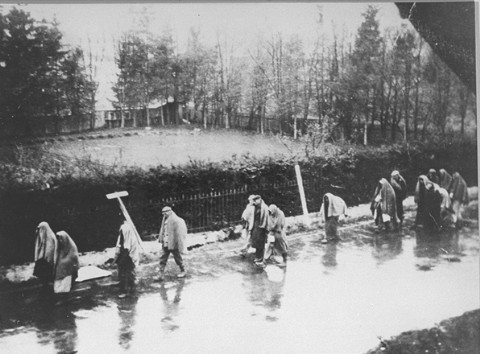Auschwitz liberation 70th anniversary: History of the Holocaust death marches

Holocaust Memorial Day marks the anniversary of the liberation of the Auschwitz, the day on which the nightmare finally ended for prisoners incarcerated in the concentration camp complex.
More than a million Jews and others died in the infamous Nazi death camp, but on 27 January 1945, only a few thousand sick and injured inmates remained at one of most poignant symbols of Nazi cruelty.
For those who had already left the camp, the journey ahead was the start of more hardship. The largest death marches took place in the winter of 1944 to 1945, when the Soviet army began its liberation of Poland.
Military defeat
In the summer of 1944, an offensive in eastern Belarus annihilated the German Army Group Centre and permitted Soviet forces to overrun the first of the major Nazi concentration camps, Majdanek, situated on the outskirts of the German-occupied Polish city of Lublin.
As the Red Army approached through Poland in November 1944, SS chief Heinrich Himmler ordered gassing operations to cease across the Reich. The crematoria at Auschwitz were dismantled, and the Sonderkommando – work units of German Nazi death camp prisoners – were ordered to remove other evidence of the killings, including the mass graves.
By January 1945, the Third Reich stood on the edge of military defeat. Most of German East Prussia was under Soviet occupation and the Red Army besieged Warsaw in Poland and Budapest in Hungary. Anglo-American forces in the West were poised to invade Germany, after the failure of the surprise German Ardennes offensive in December 1944.
One week before the liberation, prisoners' records were destroyed and buildings were demolished. Himmler ordered the evacuation of all camps, charging camp commanders with making sure "not a single prisoner from the concentration camps falls alive into the hands of the enemy".
The evacuations were ordered for several reasons, including to prevent prisoners from being able to testify against the SS to Allied and Soviet liberators. Himmler, and a few other SS leaders, also irrationally believed that they might be able to use Jewish concentration camp prisoners as hostages to bargain for a separate peace in the West that would guarantee the survival of the Nazi regime.

Death marches
The first evacuation of Majdanek inmates started in April 1944. Prisoners of Kaiserwald concentration camp in Latvia were transported to the Stutthof camp near Gdańsk or killed in August. Mittelbau-Dora, a subcamp of Buchenwald concentration camp in Germany, was evacuated a year later in April 1945. In the same month, satellite labour camps around the Dachau camp were cleared out, with around 15,000 prisoners sent on a death march towards the Austrian border.
Dressed in rags, thin uniforms and wearing wooden clogs, inmates from all Nazi concentration camps faced marching for miles in temperatures below freezing. Seven hundred prisoners were killed during one 10-day march of 8,000 Jews, who were being moved from camps in the Danzig region. Those still alive when the group reached the coast were forced in the Baltic Sea and shot.
The largest death march took place on 17 January, when 58,000 prisoners from Auschwitz-Birkenau were marched under guard, largely by foot to Wodzisław Śląski. Those not fit enough to walk, having already endured violence, slave labour and starvation, were killed before the death march began.
Prisoners unable to keep up on the march were killed. Having walked for miles in several feet of snow, some survivors were then transported for days at a time with no food, water or shelter in train carriages designed for cattle. On arrival at their destination, they were forced to march again to new camps. Approximately 15,000 prisoners from Auschwitz died on the way, in what was later deemed crimes against humanity in the Nuremberg Trials.
Elie Wiesel, winner of the 1986 Nobel Peace Prize, recalled in his 1958 memoir Night how he and his father were forced on a death march from Buna (Auschwitz III Monowitz) to Buchenwald concentration camp.
"Pitch darkness. Every now and then, an explosion in the night. They had orders to fire on any who could not keep up. Their fingers on the triggers, they did not deprive themselves of this pleasure. If one of us had stopped for a second, a sharp shot finished off another filthy son of a bitch. Near me, men were collapsing in the dirty snow. Shots."
© Copyright IBTimes 2025. All rights reserved.




















